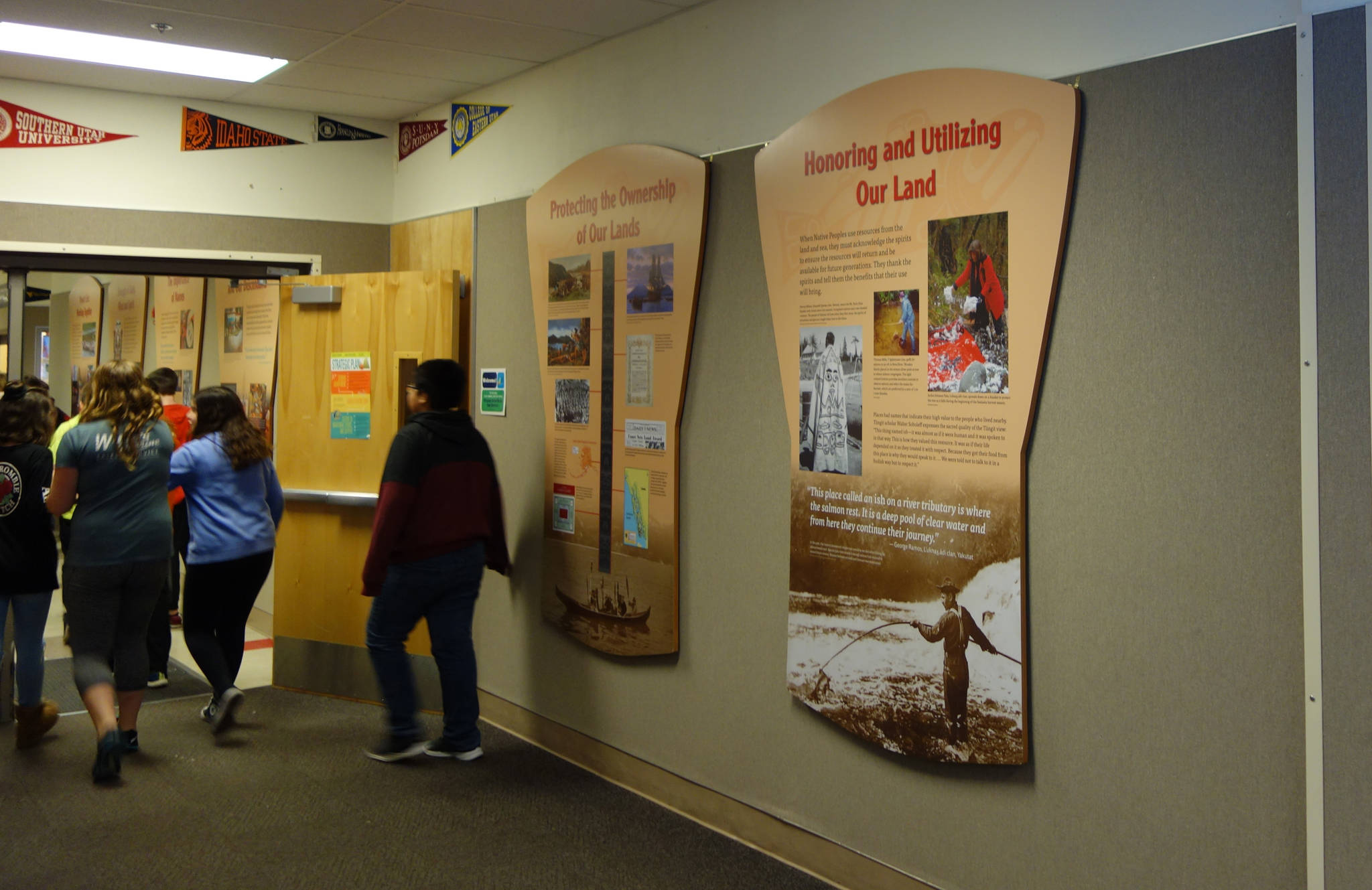On the day before Thanksgiving, Floyd Dryden Middle School’s gymnasium floor filled with students dancing to a Tlingit song — sung by other students — about respecting elders and community members. Elders and school administrators joined in.
This was at the close of the “Transfer of Core Cultural Values Panels Ceremony.” Sealaska Heritage Institute donated eight panels originally displayed in the Nathan Jackson Gallery for the middle school’s main hall. SHI’s gallery will host a new exhibit in May 2018 called Aan Yátx’u Sáani (“People of the Land” in Tlingit). It will include an interactive exhibit on place names, halibut hooks, and intertidal salmon traps, and will be on display for three to five years.
“The panels displaying our core cultural values with photos of contemporary life of Southeast Alaska Natives will demonstrate to students and teachers alike that our culture is a living culture and is not a relic or artifact of the past,” President of SHI Rosita Worl said prior to the event. “The photos also provide insight into our cultures that more often students are not able to experience and introduces students to cultural diversity. The students today may be in positions in the future where they may make decisions that affect indigenous cultures. With the knowledge they have gained, they may be inclined to make decisions that support cultural diversity.”
SHI is assessing how to bring similar panels to other schools who have expressed interest, Worl said.
Elder David Katzeek of Shangukeidi clan said values have been laid aside by many organizations and institutions; the effect of students not being taught values can be seen on the national level in the U.S., he said after the event.
“If you don’t teach values – and I’m not talking about just Tlingit values, to love each other is universal, to be kind to each other is universal, to respect the boundaries of your brother, your sister, your mom, your dad, your auntie, your uncle, the bear, the fish, the moose, the goat – you’re missing it all. When we called each other noble children of the earth, if we mistreated the earth, we were mistreating ourselves and those are the things that basically kept us here for thousands upon thousands of years, and we will be here as long as we continue to practice it. There’s a lot of people who quit practicing their values; they’re not here any longer.”
During the ceremony, speakers spoke on what core cultural values are and the importance of cross-cultural understanding. The core values: Haa Aaní: Our Land: Honoring & Utilizing our Land (Haida: Íitl’ Tlagáa; Tsimshian: Na Yuubm); Haa Latseen: Our Strength: Strength of Body, Mind, and Spirit (Haida: Íitl’ Dagwiigáay; Tsimshian: Na Yugyetga’nm); Haa Shuká: Past, Present, and Future Generations: Honoring our Ancestors and Future Generations (Haida: Íitl’ Kuníisii; Tsimshian: Na Hlagigyadm); Wooch Yax: Balance: Social and Spiritual Balance (Haida: Gu dlúu; Tsimshian: Ama Mackshm).
As Principal Jim Thompson accepted the gift of the panels from SHI, he told all gathered that he hadn’t been sure what he was going to say when he spoke, but he listened to what the elders and members of SHI said during the ceremony. Their words, he said, reminded him of a memory. His wife came from a different culture, he said, and at his wedding when someone gave a traditional Irish toast, he said “Your family is now a blanket. May your fabric be strong and your colors bright.”
“…I looked across this room, and if you were in my shoes right now, you’d understand why my feet are trembling. I see across this sea of faces and I see a tapestry of beauty. …..When I see this tapestry I think of a blanket, I think of the fabric of a blanket, and each and every one of you is a piece of that fabric of that blanket and part of these panels that we’ve taken on is we’re identifying, honoring, and respecting every fabric that is a part of our blanket….through these panels today, I see that our fabric is becoming strong. I see the colors that we honor are becoming brighter. We do not want to have a single, solitary color for a blanket. We want to see the tapestry, the beautiful tapestry that I see in my shoes,” Thompson said.
• Clara Miller is a staff writer for the Capital City Weekly.

